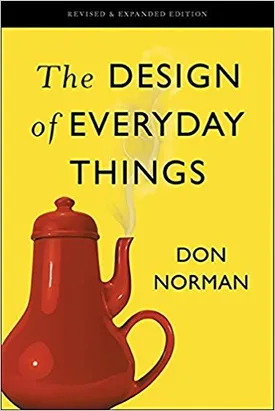The Design of Everyday Things by Don Norman
The Design of Everyday Things by Don Norman is an iconic book and “must-read” for any UX designer. Don Norman, a cognitive scientist and professor, uses the insights he gained from his studies and years of researching to explain why some products become so popular while others just don’t make the cut. Releasing in 1988, the book is full of timeless principles and approaches to design, which he calls usability design.
The foundational concept of The Design of Everyday Things is that it’s not the user’s fault when something isn’t working properly. Instead, it’s the fault of the designer for not creating a product that’s easy to use. In the book, Norman outlines seven basic principles which form the basis of good design: visibility, mapping, feedback, constraints, conceptual models, agreement and using a language user’s understand. The book outlines how Norman came to these principles and explains how designers can use them in order to create successful products.
Norman explains the importance of visibility; things should be self-explanatory when used, enabling users to understand how to use the product. Visibility also covers cues and goals, which are fundamental to usability. In a product with good visibilty, cues should show the user how to interact with the product, and how to achieve the desired goal.
Mapping is another important aspect of design, as it can help bridge the gap between user’s goal and the platforms they are using. Rather than sticking to one interface, Norman argues that it is important to think about both physical and mental mapping. Physical mapping refers to how products can be ‘chunked’ into understandable pieces, so users can fulfill their goals without getting frustrated or lost. Mental mapping is about the users creating strands of thoughts about the product and their goals, so the process and paths can be understood easily.
Norman also emphasizes the importance of using feedback in design, over simply providing instructions. Through shapes, text or display mechanics, designers should guide the users through their tasks without explicitly telling them what to do. Through feedback, users should be able to gain an understanding of what needs to happen next to complete their task.
Constraints are another key factor in the design of everyday things. This involves setting limits to the user’s choices to help them stay focused on their tasks. It also allows them to avoid making mistakes. This can include disabling irrelevant items, adding physical barriers such as fences in retail stores, or limited user options such as radio buttons.
The book also discusses the importance of conceptual models. As with anything, it’s important to explain in simple terms the tasks that need to be completed by the user. Making conceptual models provides higher-level information, so users can figure out what tasks need to be done without getting confused or lost.
Agreement is yet another principle which Norman proposes for the design of everyday things. This means ensuring users agree with products by using any type of design to try to make use of the products enjoyable and fulfilling. This can come from the shape of the product, or the type of language used to describe it.
Finally, Norman stresses the importance of using a language users understand. By thinking of target users’ context and style of language, designers can make sure users don’t become confused by products. It’s important to practice empathy and think before implementing designs.
The Design of Everyday Things by Don Norman is timeless, remaining relevant and insightful three decades after its initial release. Since its release, the book has become a staple for design, having been a cornerstone of product design learning for many. Through his seven basic principles, Norman has outlined what makes product design successful and how designers should approach them in everyday design. He tackles complex concepts with ease, and readers emerge from the book with an understanding of the psychology and principles needed to create the best products.

